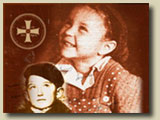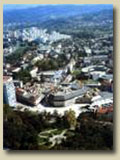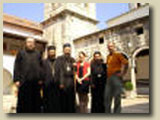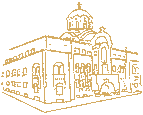| Information
Service of
the Serbian Orthodox Church
July
19, 2005

COMMUNIQUE OF THE COUNCIL FOR JASENOVAC
 The Council for Jasenovac of the Holy Assembly of Bishops of
the Serbian Orthodox Church met on July 14, 2005 in the bishop’s
residence in Banja Luka. Out of its concern for the preservation
of remembrance of this new Serbian Kosovo, of the Great-martyred
Jasenovac as an event that changed Serbian history, the Holy
Assembly of Bishops in 2003 founded the Council for Jasenovac,
giving it the task of taking care of the Remembrance of the Newly
Martyred and the locations where they perished. The Council for Jasenovac of the Holy Assembly of Bishops of
the Serbian Orthodox Church met on July 14, 2005 in the bishop’s
residence in Banja Luka. Out of its concern for the preservation
of remembrance of this new Serbian Kosovo, of the Great-martyred
Jasenovac as an event that changed Serbian history, the Holy
Assembly of Bishops in 2003 founded the Council for Jasenovac,
giving it the task of taking care of the Remembrance of the Newly
Martyred and the locations where they perished.
In addition to the members of the Council for Jasenovac, the
meeting was also attended by His Grace Bishop Joanikije of Budimlje
and Niksic, a member of the Holy Synod of Bishops; Mr. Jovo Turanjanin
of the Republika Srpska Secretariat for Religions; and Professor
Vladimir Lukic, chairman of the Council for the Commemoration
of the Sixty-Anniversary of the Liberation of Jasenovac.
 Gathering in the home of Bishop Jefrem of Banja Luka and chaired
by Bishop Atanasije (Jevtic), the members of the Council for
Jasenovac expressed their joy that the commemoration of the sixty-year
anniversary of the liberation of Jasenovac on April 17 of this
year (2005) took place in an dignified manner and in the presence
of a large number of attendees in the Memorial Zone of Donja
Gradina, especially young people, who need to accept the tradition
regarding the extermination at Jasenovac and pass it on through
history. Gathering in the home of Bishop Jefrem of Banja Luka and chaired
by Bishop Atanasije (Jevtic), the members of the Council for
Jasenovac expressed their joy that the commemoration of the sixty-year
anniversary of the liberation of Jasenovac on April 17 of this
year (2005) took place in an dignified manner and in the presence
of a large number of attendees in the Memorial Zone of Donja
Gradina, especially young people, who need to accept the tradition
regarding the extermination at Jasenovac and pass it on through
history.
A special joy was the fact that the anniversary took place in
cooperation between all three of the peoples who suffered [at
Jasenovac]: the Serbs, the Jews and the Roma. It was observed
that, unfortunately, in Serbia and Montenegro this anniversary
was not given anywhere near as much significance as in Republika
Srpska.
During the meeting the members of the Council for Jasenovac
conducted a brief overview of their two years of work. They devoted
special attention to the future of the Memorial Zone of Donja
Gradina and considered its memorial and educational uses, and
the possibility of constructing a church in Donja Gradina to
provide liturgical and traditional remembrance of the victims
of the Jasenovac concentration camp.
The Council confirmed the need to incorporate the execution
site in Draksenic into the Memorial Zone of Donja Gradina complex.
The Council is willing to support all projects – scientific,
memorial or educational – that will contribute to the finding
and publishing of the truth regarding the Jasenovac death camp.
For this purpose it will make every effort to ensure that the
roundtable of historians held this year in Banja Luka becomes
a regular event.
The Council was also most pleased to learn that in its report
regarding education about the Holocaust in the Western world,
the Organization for Security and Co-operation in Europe (OSCE)
included the work of the Serbian Orthodox Church’s Council for
Jasenovac on education of teachers among the five most exemplary
projects in the world.
The Council for Jasenovac will be organizing a seminar in October
2005 for seminary professors on Jasenovac, the New Martyrs and
the Holocaust as the historical framework within which Jasenovac
occurred. At the same time, the Council for Jasenovac will draw
the attention of the Ministries of Education of Serbia and Republika
Srpska to the importance of the Stockholm Declaration on education
regarding the Holocaust, the signing of which offers many opportunities
for the accurate and proper presentation of the tragedy of the
Second World War and its transmission to generations to come.
For that purpose the Council for Jasenovac will establish, in
addition to the already existing excellent cooperation with the
Yad Vashem Memorial Center in Jerusalem where our students are
regularly sent to be educated, cooperation with other centers
of this type in the world.
The Council placed special emphasis on the need for the liturgical
cult of the New Martyrs of Jasenovac to be transmitted to Orthodoxy
as a whole, especially that the Service to the New Martyrs be
translated into the languages of various peoples and then presented
to local Orthodox Churches.
After the meeting Bishop Atanasije (Jevtic) visited Bishop Hrizostom
of Bihac and Petrovac and they then visited execution site of
Susnjar near Sanski Most, which operated 1941-44, and Gravice
near Bihac, and the Crna Ruka abyss near Krupa. On that occasion,
Bishop Hrizostom was kindly requested to join the Council for
Jasenovac as its tenth member, which he accepted.
Bishop Joanikije visited and served memorial services at the
execution sites of Montenegrin patriots in Sibovi and Vrbas Logor
near Banja Luka, and Kakulji in Lijevce Polje, and the “brain
cemetery” in Draksenic in Potkozarje. The following day, the
members of the Council visited the Memorial Zone of Donja Gradina
and served a memorial service, then visited Bishop Sava of Slavonia
in Jasenovac. Finally, the members of the Council visited the
site of the Jasenovac concentration camp, where they were warmly
received by the director of the Memorial Zone, Natasa Jovicic,
and her associates. Bishop Joanikije served the concluding memorial
service at one of the mass graves at Jasenovac.
In conclusion, the members of the Council of Jasenovac of the
Holy Assembly of Bishops wish to express the hope and conviction
that the sixty-year anniversary of the liberation of Jasenovac
will not be, as in the past, an event after which Jasenovac and
Donja Gradina will be miserably neglected until next year. Although
late in the coming, the truth about the suffering at Jasenovac
– for Christ and the Serb name – is indestructible and at our
door because if people become silent, the stones themselves will
begin to speak. However, to get to the truth about the Orthodox
Serbs, the most numerous victims in Jasenovac, and about our
brothers in suffering, the Jews, the Roma and the anti-fascists,
there is still much effort, work and mutual cooperation and understanding
to be done on the part of all those who are working on this blessed
and salvation-bearing truth, the Truth which is the name of the
Crucified and Resurrected Christ the God-Man (John 19:6).
Only with the full truth about Jasenovac, covered up and hidden
for over half a century, will it be possible to gauge all of
the history that has occurred after Great-Martyred Jasenovac
because in addition to knowledge, we will have also have a pure
eye accustomed to the truth, which is so necessary in our age
of discord and deception, which only the Light of the Lord can
shine through and shine upon.

PILGRIMAGE TO HOLY FATHER NIKOLAI OF OCHRID AND ZHICHA  On Sunday, July 17, 2005 in the monastery of St. Sava in Libertyville
(Chicago) the Second Annual Pilgrimage to Holy Father Nikolai
of Ochrid and Zhicha was held. On Sunday, July 17, 2005 in the monastery of St. Sava in Libertyville
(Chicago) the Second Annual Pilgrimage to Holy Father Nikolai
of Ochrid and Zhicha was held.
In this holy monastery the Holy Bishop lived in the early 1950s
and was buried in 1956 until the transfer of his holy relics
to his native Lelic in 1990.
Bishop Nikolai Velimirovich was canonized a saint by the Serbian
Orthodox Church on May 24, 2005. Last year the first pilgrimage
to the Serbian saint was held. After Holy Hierarchal Liturgy,
which was served by His Eminence Metropolitan Hristifor and His
Eminence Russian Bishop Peter, a suitable program followed in
the monastery courtyard.
 Before the many Serbs who gathered a short memorial service
was served for General Draza Mihailovic near a memorial dedicated
to him on the occasion of the fifty-ninth anniversary of the
perfidious murder of the top guerrilla fighter in Europe during
World War II at the hands of members of Tito’s notorious OZNA*. Before the many Serbs who gathered a short memorial service
was served for General Draza Mihailovic near a memorial dedicated
to him on the occasion of the fifty-ninth anniversary of the
perfidious murder of the top guerrilla fighter in Europe during
World War II at the hands of members of Tito’s notorious OZNA*.
The two Archpriests then blessed the newly constructed memorial
tombstone dedicated to Holy Father Nikolai and conducted the
prayer (Atakist).
The formal Academy which is held on the first Sunday after St.
Peter’s Day in honor of St. Nikolai, began with introductory
remarks by Protopresbyter Milos Vesin, and words of welcome by
the host of the gathering, Metropolitan Hristifor.
Poet Djordje Nikolic recited verses from his canto “The Head
of the Serbs”.
This year’s keynote speaker was Mother Michaela, the abbess
of the Serbian monastery of St. Pajsije in Safford, Arizona,
who spoke with great inspiration regarding the poetry of Holy
Bishop Nikolai.
As part of the musical segment of the program, Mother Michaela
and the sisterhood sang a selection of songs from the Spiritual
Lyre of St. Nikolai in Serbian and English. It is important to
note with regard to the sisterhood of St. Pajsije Monastery that
the Abbess Mother and the sisters (numbering almost 30) are Americans
who have converted to the Orthodox faith. They do not speak Serbian
but they sing with exceptional warmth in faultless Serbian.
*OZNA or Odeljenje za Zastitu Naroda (lit. Department for Protection
of the People) was a security agency of the communist Yugoslavia.

BELGRADE TV TEAM VISITS DIOCESE OF DALMATIA   At the beginning of the month of July a Belgrade Television
team visited the Diocese of Dalmatia with the goal of filming
a follow up program about the situation in the region of Dalmatia.
Three years ago this team filmed a documentary about Dalmatia
for the YU Info program. At the beginning of the month of July a Belgrade Television
team visited the Diocese of Dalmatia with the goal of filming
a follow up program about the situation in the region of Dalmatia.
Three years ago this team filmed a documentary about Dalmatia
for the YU Info program.
The
program will include the life of the Diocese of Dalmatia and
the critical problems of Serb returnees to Dalmatia.

[Serbian
Translation Services]

Copyright © 1999-2004 by
The Information Service of the Serbian Orthodox Church
11000 Belgrade
Kralja Petra I no.5
+381 11 3282 596
e-mail
|

